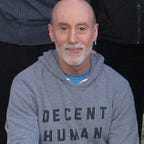Healing America’s Narratives: So, Now What?
[Part of a series, this essay is adapted from Chapter Eleven of Healing America’s Narratives: The Feminine, the Masculine, & Our Collective National Shadow. Available now.]
First, remember (or notice for the first time) that you have a body. Notice that you are breathing, and keep your attention there for a minute or so. Intentionally observe the inbreath, the pause, and the outbreath. Pretty cool. You are actually being breathed. You don’t choose or have to control the process, although you can play with — hold, quicken, or slow — it. Also notice your posture. Attune your attention to the alignment of muscles, bones, joints, and connective tissue from head to toe, including everything in between. Do this even if injury or illness impacts how you are able to hold yourself.
Breath and posture: always with us, useful, important, and influenceable.
The previous essays in this series took us on a journey through selected narratives that disclose our collective American Shadow — the themes, episodes, and general aspects of our stories that we don’t recognize or own and often project onto others. The book’s title and subtitle invite us to engage the process of healing these narratives by owning and integrating our denials and projections. As used here, healing does not mean curing or fixing (which have their respective places), but coming to terms with things as they are, with an awareness of how they have been, in order to live into ways of being that are increasingly inclusive, integrated, and balanced. Coming to terms with things as they are means recognizing and accepting that things are as they are — acknowledging what’s literally true in the moment. Acceptance does not necessarily mean agreeing with, condoning, liking, or endorsing how things are.
In healing — coming to terms with — America’s narratives, owning and integrating requires the intentional practice of truth, beauty, goodness, justice, mercy, wisdom, compassion, courage, discipline, humility, and love, among some more tangible strategies and tactics. Owning and integrating our traumatic or uncomfortable narratives is not intended to bring us to a place of oh, no, we are a nation of ignorant, arrogant, fearful, bigoted, violent, greedy, excessive, untrustworthy bullies, but rather to a still necessarily discomfiting but more skillful place of oh, yes, we have manifested, and continue to manifest ignorance, arrogance, fear, bigotry, violence, greed, excess, untrustworthiness, and bullying, along with deep knowing, humility, love, openness, peace, generosity, moderation, trustworthiness, and courage in our behaviors toward each other and the rest of the world. It is from this place of paradox and integrity — of both of these are true — that we can develop and begin to embody our potential to be integrated, fully human beings, at work, at home, on the street, and in the best and the worst of times.
Our intention is to consider, imagine, wonder, and wander toward and through ways of looking at, being and interacting with, sharing, and structuring our world that transcend and include our cultural givens and what we have thus far constructed for ourselves. We’ll journey together along paths that can help heal our collective narratives and the traumas that arise from and contribute to them. Skillful means, development, applying skillful means to development, intentional practice, and commitment to the broadest, deepest view possible will accompany us along the way.
We’ll begin with five questions and two statements that encourage individual exploration and can be engaged as intentional practice. In subsequent essays we’ll explore each question and statement in detail and then move into an exploration of our collective narratives.
- Who am I, really?
- Everything is a story.
- What’s my impact & what impacts me?
- What am I not seeing?
- Who are my people?
- I am going to die.
- How am I in relationship with each of the above questions and statements — and the rest of my life?
That’s it for now. Don’t wait for future essays to play with these questions and statements. Agree or disagree, inquire deeply. Who do you truly think you are? What’s your story about the prospect that everything is a story? What’s your impact and who or what impacts you? What are you missing? Who are your people (and what does that even mean?). You are going to die. How are you in relationship with all of this and the rest of your life?
This might take a while. Don’t rush. Definitely don’t copy anyone else’s answers.
